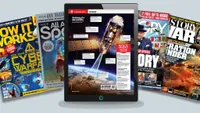Here's what scientists heard when Mercury-bound BepiColombo flew past Earth
Listen to the sounds of our planet as the spacecraft gears up for its close approach of the solar system's innermost world.
BepiColombo captured five eerie recordings as it whizzed past Earth at a speed of 2.159 miles (3.474 kilometers) per second, according to a statement from the European Space Agency (ESA) on May 5.
The European-Japanese mission's flyby on April 10, the first of nine gravity-assist maneuvers, helped to tighten the spacecraft's trajectory around the sun, slingshotting it onto an orbit that will bring it closer to its destination: Mercury — the smallest and least explored planet in the solar system.
According to ESA, BepiColombo will provide the best understanding of Mercury to date. The mission consists of two orbiters: the Mercury Planetary Orbiter (MPO), tasked with mapping the planet's surface, and the Mercury Magnetospheric Orbiter (MMO), which will get a better look at the planet's magnetosphere — the magnetic bubble generated by a planet that shields its surface from solar and cosmic radiation.
Video: BepiColombo's Earth approach sounds: Accelerometer data sonified
Related: Did Mercury once have the ingredients for life?
The craft used two out of a suite of 11 instruments on board the MPO — the Italian Spring Accelerometer (ISA) and its magnetometer (MPO-MAG) — while the craft began a sequence of passes. The probe made a close approach to Earth, slipping into our planet's shadow and listening closely to the Earth's magnetic field before finally speeding out of our planet's influence.
These recordings will be invaluable in the future, being of particular use in calibrating the instruments and preparing for further measurements, MPO-MAG Principal Investigator Daniel Heyner said in a statement.
BepiColombo approaches Earth
Between distances of 159,315 miles to 80,460 miles (256,393 kilometres to 129,488 kilometres), the ISA captured eight hours of measurements from aboard BepiColombo. Seeking out frequencies lower than those audible to the human ear, the accelerometer recordings have been condensed into a minute of sound before being enhanced by researchers at Italy's National Institute of Astrophysics (INAF).
Breaking space news, the latest updates on rocket launches, skywatching events and more!
"The vibrations caused by the external and internal factors are transmitted into our accelerometer," ISA team member Carmelo Magnafico said in a statement. "It's the same principle to when you put your ear on a rail to hear whether the train is coming."
Earth within reach
Getting closer to the planet's surface, between distances of 17,326 miles to 8,144 miles (27,884 kilometers to 13,107 kilometers), BepiColombo was able to tighten its trajectory around the sun. To do this, the spacecraft used Earth's gravity when it swooped to a distance of 7,884 miles (12,689 kilometers) from the surface at its closest point of flyby. Data from the ISA has been compressed so that one hour of measurements equate to a minute of audio.
Slipping into Earth's shadow
With the sun blotted out by Earth, BepiColombo lost sight of our star in this 34-minute clip from the ISA at a distance of 10,250 miles (16,496 kilometers), a moment that is clearly audible in the recording. Beginning at a distance of 8,363 miles (13,460 kilometers), the MPO can be heard exiting the eclipse at a distance of 15,447 miles (24,861 kilometers).
"When the spacecraft enters the shadow and the force of the sun stops, we can hear a slight vibration,” Magnafico said in a statement. "The solar panels, previously flexed by the sun, then find a new balance. Upon leaving the shadow, we can hear the effect again."
Registering the subtle solar influence so clearly means that ISA is well-equipped to capture even the smallest differences in motion. To Magnafico, this is quite an extraordinary situation.
"Since we started the cruise, we have only been in direct sunshine, so we did not have the possibility to check effectively whether our instrument is measuring the variations of the force of the sunlight," Magnafico said. "This proof for us that the instrument is quite well-calibrated because the jump in the acceleration we measured is in line with our expectations."
As the orbiter pulls further away from Earth's influence, the recording ends when the MPO hits a distance of 19,750 miles (31,785 kilometers) from the surface.
The sound of Earth's magnetic field (and BepiColombo's flywheels)
Flying through the Earth's magnetic field, this clip was recorded by BepiColombo's magnetometer before compressing eight hours into 26-second audio track. It highlights the moment the spacecraft encounters Earth's bow shock, the point where our planet's magnetosphere crashes into the solar wind.
Passing through to the turbulent magnetosheath, BepiColombo can then be heard crossing the magnetopause — the region after which Earth's magnetic field begins to dominate. Listen closely and you'll hear the thud of the spacecraft's reaction wheels, which point the orbiter in the right direction for observations.
- Weird! Mercury's scorching temps may actually lead to ice
- This stunning crescent Earth is the last view of home from the Mercury-bound BepiColombo
- What a view! Mercury probe snaps stunning photos of our planet during Earth flyby
Gemma Lavender is the author of Quantum Physics in Minutes (Quercus, 2017) and Haynes Owner's Workshop Manual: Milky Way (Haynes Publishing, 2019), among other books. Follow her on Twitter @Gemma_Lavender. Follow us on Twitter @Spacedotcom and on Facebook.
OFFER: Save 45% on 'All About Space' 'How it Works' and 'All About History'!
For a limited time, you can take out a digital subscription to any of our best-selling science magazines for just $2.38 per month, or 45% off the standard price for the first three months.

Gemma currently works for the European Space Agency on content, communications and outreach, and was formerly the content director of Space.com, Live Science, science and space magazines How It Works and All About Space, history magazines All About History and History of War as well as Science, Technology, Engineering, Arts and Mathematics (STEAM) kids education brand Future Genius. She is the author of several books including "Quantum Physics in Minutes", "Haynes Owners’ Workshop Manual to the Large Hadron Collider" and "Haynes Owners’ Workshop Manual to the Milky Way". She holds a degree in physical sciences, a Master’s in astrophysics and a PhD in computational astrophysics. She was elected as a fellow of the Royal Astronomical Society in 2011. Previously, she worked for Nature's journal, Scientific Reports, and created scientific industry reports for the Institute of Physics and the British Antarctic Survey. She has covered stories and features for publications such as Physics World, Astronomy Now and Astrobiology Magazine.


